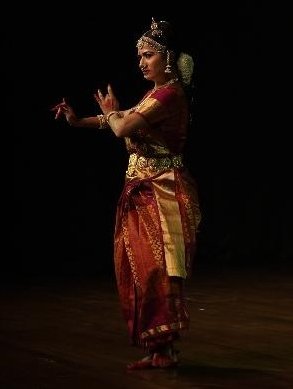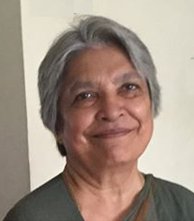
|   |

|   |
Bhakti Se Mukti - Tapati Chowdhurie e-mail: tapatichow@yahoo.co.in Photo: Bhavna Shah October 6, 2023 'Bhakti Se Mukti' by Chitra Dalvi was more than an entertaining dance performance. It schooled the rasikas, who went back home enriched on what "Bhakti dwara Mukti" was all about. Chitra Dalvi has been blessed with a guru like Dr. Sandhya Purecha - she became her disciple at the tender age of three and half - and is still under her care. An opportunity to see her dance came to me, when I was invited to her Bharatanatyam performance at Nita Mukesh Ambani Cultural Centre, Mumbai. It was a rainy evening when I reached the venue to witness the Tanjavur style of the genre. Dr. Sandhya Purecha herself has been trained under Acharya Parvati Kumar, who through extensive research, brought to Maharashtra the Marathi Nirupanas composed by the great patron of Bharatanatyam, Serfoji Maharaj Bhosale of Tanjavur. 'Bhakti Se Mukti' was a one-of-its-kind evening. Sutradhar Sunil Sunkara built a bridge between the performer and the audience by educating the audience at every point on the concepts and subject matter presented by the dancer, with chunks of facts mixed with generous dollops of humour, so much so that rasikas and performer - the receiver and the giver - enjoyed aesthetic bliss. After the chant of the salutation to the Devi who lives in all beings in the form of art, the sutradhar said that dance is the coming together of movement and stillness - sthithi and gati. When the two combine, gnan and shakti come together. Shiva is known to be the god of dance but the power of movement within him is Shakti, which manifests in all art. So 'Tri Shakti Kauttuvam' was the first piece that was presented. Chitra praised the three energies of Shakti - Saraswati, an epitome of knowledge; Parvati, an epitome of power and strength; and Mahalakshmi associated with beauty and one who is the Devi of lasya. After paying her obeisance to Devi who is the consort of Narayana and one who has all the attributes of auspiciousness and fulfils the objectives of devotees, she danced in praise of all the manifestations of Devi's larger than life qualities highlighting each of her characteristic attributes. Rasikas soaked in the beauty of the dancer's adulation of Devi. Covering the stage with a karana pose to represent Devi grabbed the attention of all. Intensity of expression and pure dance sequences told the story of the Devis.  Chitra Dalvi What is Bhakti? Bhagwat Mahatmyam has personified Bhakti as a beautiful woman who was born in South India, grew up in Karnataka and then went to Maharashtra and Gujarat where she became a worn out old woman, but on reaching Vrindavan she was renewed into a woman of superb appearance by Krishna, who resides in all of us. Mukti is surrendering of all ego. Bhakti or devotion and mukti or liberation is for all beings. Chitra Dalvi's performance led the rasikas to reach their true goal, which is the aesthetic relish of liberation and experience rasa. The performer's versatility poured forth in the Mangala Mantra chant. A humble chant directed to the Mangal Graha aimed towards removing poverty and illness in all sincerity was both fulfilling and a cathartic experience. What kind of an audacious statement did 'kapadi' Hari make to the nayika and what emotions went through the mind of the pragalba nayika? The big fat hypocrite -"kapadi mota Hari"- says the nayika, is cunning to the hilt. The enacting of mock anger of a confident lover of Krishna to her sakhi was, Hari had dared to tell her that she should love him no matter what he does and later his appalling action of not showing up when plate in hand, with a garland, sandal paste and perfume in it, she eagerly awaited his arrival. This was truly enjoyable. To further wound her, she confided to her sakhi that naughty Krishna had given away the first blossoms of a sapling they had planted together, nurtured it and had indulged in love dalliance around it. This had a mixture of poignancy and humour. The portrayal of a nayika who is mature and confident in the art of love was essayed through the rasas of disgust, love, mock anger, sarcasm and peace. The first line "Hari hey mota kapadi" was picturesquely danced with abhinaya to the varnam in raag Anand Bhairavi and adi talam, a composition of Serfoji Bhosale - the former ruler of Tanjavur State, who was an exponent of the classical arts of music and dance. Choreographer Sandhya Purecha wove the sahitya intricately, interlacing it with Panchajati to make it an impressive work of art. Chitra brought this wonderfully layered nayika of "Mota kapadi Hari" to aficionados of dance in a gem like interplay of nritta, nritya and abhinaya. Chitra's incredible stamina, postures, gestures and the use of karanas were remarkable. She went through each and every piece strictly adhering to the tenets of Bharatanatyam, perfect ardhamandalis, carefully practised leaps and jumps and going round the stage while on her knees singled her out as a frontline Bharatanatyam dancer of her generation. Swati Tirunal's keertanam "Shankara Sri Giri Natha Prabhu" is a piece in expressional dance, where the lines of the lyrics on Shiva were interwoven with jathis and swaras. The description of Nataraja preceded the devotional piece on Shiva, who dwells in the holy divine mountain in Kailash with ashes covering his body, wearing a garland of skulls around his neck, dancing with his Bhuta gana and sage Bhrungi. The devotee Swati Tirunal visualises the blossoming of sruti, rhythm and gati of Shankara in the heart of his ishta devata Padmanabha Swamy. A bond is thus created between Shiva and Vishnu. The bonding was eventually followed up in the finale, which was a Tillana in raag Dhanasri to a composition by Swati Tirunal; "Padmanabha tumhari leela mai kya kahu nach rahi gopi" exhibited exuberance of rhythm along with sculpturesque poses and technical purity. Sutradhara Sunil Sunkara made us recall Shiva's intense awe of Krishna. After all had he not once joined Krishna in his Raslila in the guise of a gopi? The vocalist Keertana Krishnamurthy, mridangist Satish Krishnamurthy and violinist V. Anantaraman mesmerised with their rendition. The bouquet of well-chosen dance pieces was greeted with appreciation. Prior to the tillana, Chitra had drawn our attention to the journey of the Varkaris where the resonance of the utterance of the word Vithala brings us salvation. So powerful was the chanting of the name of Vithala that the audience clapped instinctively to the heart-warming beats of the chant. Satvik bhava resonated in the hearts of the rasikas. 'Bhakti Se Mukti' was rendered to an appreciative audience, who, even if momentarily, experienced mukti.  Tapati Chowdhurie trained under Guru Gopinath in Madras and was briefly with International Centre for Kathakali in New Delhi. Presently, she is a freelance writer on the performing arts. |